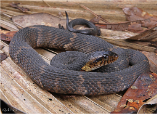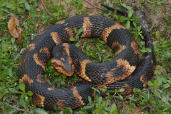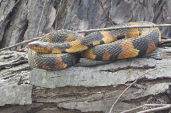Broad-Banded Water Snake (Nerodia fasciata confluens)
Description: Adults of the banded water snake measure from 24.0 to 42.1 inches in total length, with a record size (in the Florida subspecies) of 62.5 inches in total length. In one study, the average body mass of adult banded water snakes was 16.38 oz.
It is typically gray, greenish-gray, or brown in color, with dark crossbanding. Many specimens are so dark in color that their patterning is barely discernible. The ventrum (belly) is typically an off-white to white. They have flat heads, and are fairly heavy-bodied. Banded water snakes may also be identified by a dark stripe which extends from the eye to the angle of the jaw. If irritated, they release a foul-smelling musk to deter predators. This species also exhibits sexual dimorphism in which the female is generally longer and heavier than the male. The average frequency of skin shedding has been found to be every four weeks. Their appearance leads them to be frequently mistaken for other snakes with which they share a habitat, including the venomous cottonmouth.
Habitat: N. fasciata inhabits most freshwater environments such as lakes, marshes, ponds, and streams. Banded water snakes are active both day and night and may be seen basking on logs or branches overhanging the water or foraging in shallow water. They will typically stay within emergent vegetation along the shoreline or in the shallow littoral zone of their habitat.
Range: N. f. confluens is indigenous to the U.S. central lowlands including eastern Texas, extreme southeastern Oklahoma, Arkansas, Louisiana, extreme southeastern Missouri, western Mississippi, extreme western Tennessee and Kentucky, and the extreme southern tip of Illinois
Diet: The species preys mainly on fish and frogs. On occasion, they prey on small turtles, small snakes, birds, earthworms, and crawfish. Juveniles mainly consume fish and shift towards eating frogs as adults. This shift may be caused by large frogs being mechanically too difficult for juveniles to consume (which may suggest juveniles may be unable to open their jaws wide enough for adult frogs), because large frogs are energetically too costly for juveniles to catch, or because juveniles are at risk if swallowing prey requires a long time.
Reproduction: The species is viviparous, giving birth to live young. The brood size varies from 15 to 20 young born in late July or August. Newborns are about 8.0 to 9.5 inches in total length. The banded water snake is able to hybridize with the common watersnake, although this is not frequent. Physical characteristics are insufficient to distinguish such hybrids, and DNA analysis is required.
Status: Listed as Least Concern in view of its wide distribution, presumed large population, and because it is unlikely to be declining fast enough to qualify for listing in a more threatened category.
»» Kingdom: Animalia - Animals
»» Phylum: Chordata - Chordates
»» Subphylum: Vertebrata - Vertebrates
»» Class: Reptilia - Reptiles
»» Order: Squamata - Scaled Reptiles
»» Suborder: Serpentes
»» Superfamily: Colubroidea
»» Family: Colubridae - Colubrids
»» Genus: Nerodia
»» Species: Nerodia fasciata - Banded Water Snakes
»» Subspecies: Nerodia fasciata confluens - Broad-Banded Water Snake
This article uses material from the Wikipedia article "Banded Water Snake", which is released under the Creative Commons Attribution-Share-Alike License 3.0. Content may have been omitted from the original, but no content has been changed or extended.
|













